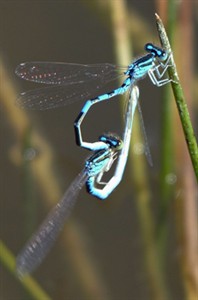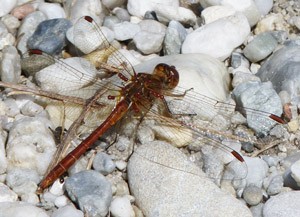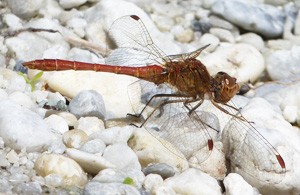More unusual Odonata in W Madrid
John Muddeman
24/08/2010 23:58:52
Recent records of Dainty and Mediterranean Bluets and Southern Darter confirm the high quality of the odonate fauna of the Western Sierras of Madrid
Posted in: Dragonflies and Damselflies | Madrid | Mainland Spain, Central Spain
 Dainty Bluet pair copulating
Dainty Bluet pair copulating
Coenagrion scitulum© John MuddemanThe same fieldwork which turned up the first Pronged Clubtail for Madrid and perhaps Ávila (see previous blog entry) has also led to the discovery of several other scarce species in the region, again highlighting the relative lack of prospection in the region but the continued presence of high quality habitats.
The first involved a small colony of Dainty Bluet Coenagrion scitulum, discovered among the sparse emergent vegetation towards the shallow upper part of a small hill reservoir on 28th July. A few mobile males and at least three pairs (either copulating or in tandem) were noted, all but confirming breeding at the site. Few other species were present, though a couple of male Blue Emperors Anax imperator fought for the airspace and a fine male Black-tailed Skimmer Orthetrum cancellatum patrolled underneath.
Dainty Bluet has apparently only been recorded from three 50x50km squares in C Spain, with one of these pre-1980 (Boudot et al. 2009) and this record apparently falls in a new quadrat. However, recent intensive surveying has shown it to be widespread across Extremadura (Sánchez et al. 2009) and particularly the N of this region in similar habitats to those found in SW Madrid, and so its presence at more sites can almost certainly be expected.
Dainty Bluet is apparently listed as Vulnerable (VU) at the international level by the IUCN (though it doesn't appear on the www.iucnredlist.org website) and is listed as Vulnerable at the national level (Torralba-Burrial et al. 2010).
 of Mediterranean Bluet@Coenagrion caerulescens.jpg) Mediterranean Bluet pair in tandem
Mediterranean Bluet pair in tandem
Coenagrion caerulescens© John MuddemanThe second of particular note was the discovery of a small number of Mediterranean Bluet Coenagrion caerulescens on 14th August along a warm, shallow stretch of river with abundant grass growing out from the bank and forming floating mats, among which a few males, a single female and also a few pairs were perching (with egg-laying observed twice).
As for Dainty Bluet, there are records just three 50x50km squares in C Spain, though all are post-1980 and may include this site. In stark contrast to Dainty Bluet though, the species is remarkably uncommon in Extremadura, having only been found in six 10x10km squares to date, possibly reinforcing its apparent scarcity in Spain (see Boudot et al. 2009). Perhaps surprisingly, it is considered as of Least Concern by the IUCN, but is considered Vulnerable at the national level (Torralba-Burrial et al. 2010).
The final record of most note was the discovery of two rather small, 'bland-looking' and quite pale darter males along the course of a dried-up river bed. Although very flighty, the presence of several parasitic mites on the wings of both individuals - not a  Male Southern Darter
Male Southern Darter
Sympetrum meridionale© John Muddemancommon sight here - meant I persisted with the ID, and after checking the field guides, their identity as Southern Darters Sympetrum meridionale was confirmed. This was later reconfirmed with the observation of several males and females, along with Ruddy S. sanguineum and a female Moustached Darter S. vulgatum in E Austria just a couple of days later. These two males were photographed there.
Southern Darter appears to have something of an enigmatic status in Spain, with just three 50x50km squares with pre-1980 records in C Spain, though there are one or two more recent records from N Madrid, and information gleaned from the recently formed Iberian ODO-GIO odonate forum shows records of multiple sightings in the Doñana area and in Galicia this autumn. It is currently listed as Data Deficient at the national level (Torralba-Burrial et al. 2010).
 Male Southern Darter
Male Southern Darter
Sympetrum meridionale© John Muddeman
But the status of many species in Madrid remains poorly known, and most spectacularly, two recent observations show two more new species are present in the region. Photos by Abel López in Biodiversidad Virtual illustrate a copulating pair of Epaulet Skimmer Orthetrum chrysostigma and also a superb adult male Green Hooktail Paragomphus genei. These also perhaps illustrate how the odonate fauna is changing and how species formerly apparently restricted more to the far SW are expanding N.
Read more blog posts